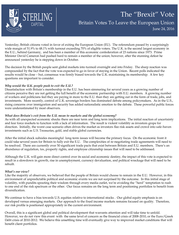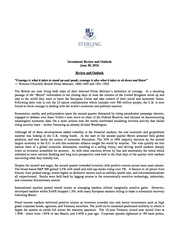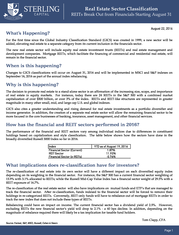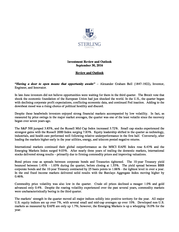Description
Page 6
activity. Maintaining diversification across market capitalization will be important as leadership is expected to shift
rapidly as risk tolerances gyrate.
Outside of the U.S., we maintain our long term exposure to international markets although we are underweight
relative to U.S. equities. We expect global markets to be the victim of sharp volatility as we close out the year.
Although unsettling in the near term, non-U.S.
markets account for over 50% of global capitalization, provide positive growth opportunities, and offer improving valuations. Our fixed income strategy remains consistent with where we have been positioned throughout the year. Our portfolios are positioned defensively with intermediate and long-term portfolios managed short versus their benchmarks. Slowly improving economic growth favors overweighting corporate securities relative to Treasury and agency bonds.
Municipal bonds lagged taxable bonds in the third quarter – making their valuations more attractive than earlier in the year. Consistent with consensus the Fed opted to not raise interest rates in September. In our view the combination of the upcoming presidential election and persistently slow growth allows the Fed to delay action until December. The peace and quiet that defined the markets in the third quarter is behind us. The opinions contained in the preceding commentary reflect those of Sterling Capital Management LLC, and not those of BB&T Corporation or its executives. The stated opinions are for general information only and are not meant to be predictions or an offer of individual or personalized investment advice.
They also are not intended as an offer or solicitation with respect to the purchase or sale of any security. This information and these opinions are subject to change without notice. Any type of investing involves risk and there are no guarantees.
Sterling Capital Management LLC does not assume liability for any loss which may result from the reliance by any person upon any such information or opinions. Investment advisory services are available through Sterling Capital Management LLC, a separate subsidiary of BB&T Corporation. Sterling Capital Management LLC manages customized investment portfolios, provides asset allocation analysis and offers other investment-related services to affluent individuals and businesses. Securities and other investments held in investment management or investment advisory accounts at Sterling Capital Management LLC are not deposits or other obligations of BB&T Corporation, Branch Banking and Trust Company or any affiliate, are not guaranteed by Branch Banking and Trust Company or any other bank, are not insured by the FDIC or any other government agency, and are subject to investment risk, including possible loss of principal invested. .
markets account for over 50% of global capitalization, provide positive growth opportunities, and offer improving valuations. Our fixed income strategy remains consistent with where we have been positioned throughout the year. Our portfolios are positioned defensively with intermediate and long-term portfolios managed short versus their benchmarks. Slowly improving economic growth favors overweighting corporate securities relative to Treasury and agency bonds.
Municipal bonds lagged taxable bonds in the third quarter – making their valuations more attractive than earlier in the year. Consistent with consensus the Fed opted to not raise interest rates in September. In our view the combination of the upcoming presidential election and persistently slow growth allows the Fed to delay action until December. The peace and quiet that defined the markets in the third quarter is behind us. The opinions contained in the preceding commentary reflect those of Sterling Capital Management LLC, and not those of BB&T Corporation or its executives. The stated opinions are for general information only and are not meant to be predictions or an offer of individual or personalized investment advice.
They also are not intended as an offer or solicitation with respect to the purchase or sale of any security. This information and these opinions are subject to change without notice. Any type of investing involves risk and there are no guarantees.
Sterling Capital Management LLC does not assume liability for any loss which may result from the reliance by any person upon any such information or opinions. Investment advisory services are available through Sterling Capital Management LLC, a separate subsidiary of BB&T Corporation. Sterling Capital Management LLC manages customized investment portfolios, provides asset allocation analysis and offers other investment-related services to affluent individuals and businesses. Securities and other investments held in investment management or investment advisory accounts at Sterling Capital Management LLC are not deposits or other obligations of BB&T Corporation, Branch Banking and Trust Company or any affiliate, are not guaranteed by Branch Banking and Trust Company or any other bank, are not insured by the FDIC or any other government agency, and are subject to investment risk, including possible loss of principal invested. .









